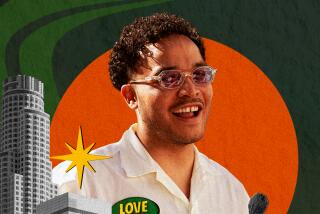Making Their Mark : Entrepreneurial Spirit and an Ear Toward the Changing Times Turn Bright Ideas Into Business Success Stories
- Share via
The client couldn’t figure out why their successful roll candy was a dud among Latino buyers. Everybody else seemed to like the fact that they contain less than 10 calories in a piece.
“But you say that to a Hispanic, and they say, ‘Phooey, I’m eating this for energy, and this has nothing in it,’ ” Carlos Garcia said.
That sort of insight now yields Garcia’s Burbank-based consulting firm, Garcia Research, about $1 million a year in revenues from companies seeking ways to latch onto the fast-growing Latino market.
“Big corporations know they need to understand the consumer base, but to them it is like doing business in Hong Kong. It scares them,” said Garcia, 42, who holds advanced degrees in business and comparative literature. “They don’t understand the culture or the language, yet the numbers are growing so fast, they can’t ignore them. So we are in an ideal situation.”
Garcia, who started his company in 1990, not only helps big companies reach Latinos. He assists Latino-owned firms going mainstream.
How big will the Latino population grow?
“I expect to be around to do Gloria Molina’s campaign for President,” he said.
Former aerospace engineer David Bantle got his idea while attending a conference at Cal Poly San Luis Obispo. He was watching someone struggling to push a friend in a wheelchair around the hilly campus.
“I thought it might be possible to come up with a device that you could add to any manual wheelchair that would convert it to a power chair,” said Bantle, 71. “It happened that my wife’s father had been in a wheelchair for 35 years, and I was aware there were a lot of needs for the handicapped.”
So 13 years ago, when the kids were grown, Bantle used some savings and turned his three-car Chatsworth garage into an office and workshop, where he worked evenings and weekends. He built his first dozen wheelchair motors in 1980, which were more portable and easier to use than anything else on the market at the time.
Now, Bantle and 35 employees build more than $2 million worth of drive motors and wheelchairs annually at his company, DAMACO, still an upstart compared to the industry’s giants.
“If there wasn’t the recession, I would probably be growing even faster than I am now,” said Bantle, who just bought a 24,000-square-foot building for the company in Moorpark. “After working quite a few years in aerospace, it’s nice to have a business of my own.”
Rosalie Duong said she’s hiring like crazy.
She’s looking for college graduates who have advanced degrees in the biological sciences as well as laboratory experience to work at Qiagen in Chatsworth, a wholly owned subsidiary of the German company Qiagen, GmbH.
The firm makes and sells kits used by researchers to purify nucleic acid, proteins, DNA and RNA from blood or any tissue.
“Our products are used by companies or universities engaged in molecular biological research,” said Duong, general manager of the local plant.
Most of the customers are researchers seeking the keys to eradicating imperfections in human cells that cause disease and disabilities. To do that work, scientists need to separate out pure cellular materials, the task performed by the Qiagen kits.
No matter how advanced the technology, one economic principle prevails: Time is money.
“With our patented technology,” said Duong, “what used to take three days takes between one and three hours.”
Thomas Asher hopes to use old-fashioned technology to battle a new plague.
Asher, founder and chairman of HemaCare Corp. in Sherman Oaks, is in the last round of the government approval process for an AIDS treatment based on a 100-year-old idea.
Using blood from people who have the HIV virus, the idea--called passive hyper-immune therapy--is to create vast pools of plasma that contain the antibodies to battle the virus. Then the plasma--or a derivative--can be transmitted to AIDS patients who can no longer produce the antibodies on their own. The same idea is used in the treatment of tetanus and rabies, he said.
“We don’t know whether it delays the inevitable or whether people will stay well,” said Asher, whose firm now sells blood components.
After two clinical trials, Asher said it looks so far as though patients receiving the treatment live longer. A third and final trial required by the federal government is expected to begin later this year, he said.
If the technology is approved, Asher expects he would need 1,000 more employees. “We don’t anticipate it would be any more expensive than the drugs available now, such as AZT,” he said.
More to Read
Inside the business of entertainment
The Wide Shot brings you news, analysis and insights on everything from streaming wars to production — and what it all means for the future.
You may occasionally receive promotional content from the Los Angeles Times.










